Selecting the right type of software architecture pattern is crucial for building scalable, maintainable, and high-performing software solutions. In this blog, we dive deep into the most popular architecture patterns, benefits, and challenges, which will give you practical insights on selecting the right pattern for your project’s needs.
The foundation of any successful software lies in its architecture. But what happens if that foundation isn’t right? Choosing the wrong type of software architecture pattern can lead to serious problems, like poor performance, scalability issues, skyrocketing maintenance costs, and even complete system failures. Not just that, this can even become the reason for collapsing the company itself.
According to one study, about 50% of a software project’s budget is often spent on rectifying errors post-implementation, highlighting the economic impact of maintenance due to quality issues.
These consequences can be terrible for businesses. Imagine an e-commerce platform struggling to handle a surge in traffic during a holiday sale or a real-time analytics tool failing to deliver insights promptly. This is considered a bad customer experience (CX).
As you’re just beginning a software development project, you can avoid such consequences by selecting the right architecture pattern from the start. This is even more important as the right architecture pattern acts as the backbone, ensuring that your software is equipped to meet current demands while staying flexible for future growth.
In this blog, we’ll explore every necessary detail about the different software architecture patterns, their benefits to businesses, and how to select the right one for your project.


What is a Software Architecture Pattern?
A software architecture pattern is your blueprint for a software system—a high-level structure that showcases the relationship between its different components, like how they interact and work together.
It provides a framework for solving common design challenges, ensuring the system is scalable, maintainable, and efficient.
Moreover, software architecture patterns become a solid foundation for developers, guiding them in organizing and building robust applications.
In simple terms, with software architecture, developers will get the idea of:
- Should everything be combined into one large system?
- Or should it be divided into smaller, independent modules?
- How should these components communicate—with direct connections or through intermediaries like messaging systems?
The end goal for software architecture patterns will be to ensure that the software is scalable, efficient, and easy to maintain.
Benefits of Choosing the Right Software Architecture Pattern
The software architecture pattern you choose plays a critical role in shaping your system’s performance and aligning it with your business objectives. Selecting the right pattern isn’t just a technical decision—it’s a strategic one that impacts the software’s long-term success.
That calls for diving into the importance of it to know the key benefits of software architecture patterns in the software development lifecycle. Let’s explore:
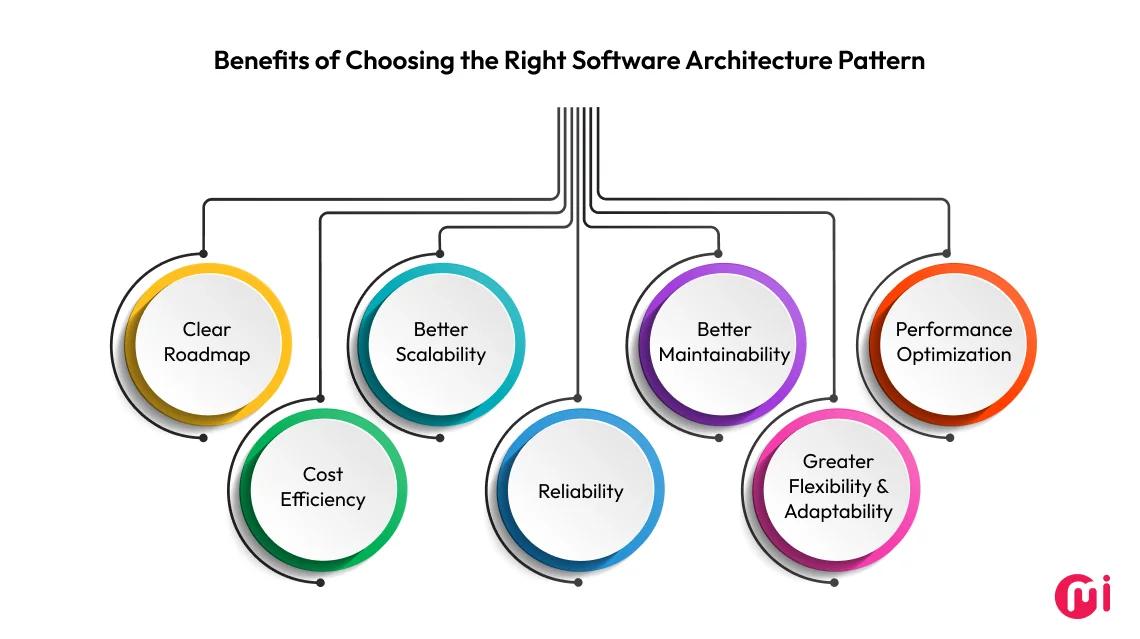

1. Clear Roadmap
You must be thinking – how a software architecture pattern associated with the performance of software gives clarity to its development roadmap?
The answer is that a well-defined software architecture pattern outlines the role and interactions of each component within, adds annotations for developers to understand the system’s design, and covers potential challenges it can face along with strategies to address such.
This leads to the roadmap creation for the software product development with long-term planning, considering all potential challenges that may arise along the way. This also eventually leads to faster software development.
2. Better Scalability
The right architecture pattern allows your software to handle increasing workloads seamlessly. Whether it’s managing a growing user base or processing large amounts of data, a scalable design ensures your system performs efficiently under pressure.
3. Better Maintainability
A well-chosen pattern enables developers to write code in modules and in a clean and understandable way, making the codebase easier to understand, update, and debug.
When the code is easy to skim through, it reduces development time and costs, especially when adding new features or fixing issues.
4. Performance Optimization
An effective type of software architecture pattern covers everything from organizing effective workflows to optimizing the placement and how components interact, leading to better system performance.
Whether ensuring lower response times, effective load handling, or streamlining operations, the right architecture ensures your software delivers efficient services to end users.
5. Cost Efficiency
The right architecture pattern minimizes development and operational costs by avoiding unnecessary complexity and designing for resource efficiency.
This includes reducing expenses related to infrastructure, debugging, and scaling while ensuring you get the best return on investment.
6. Reliability
A reliable architecture pattern ensures your system can handle failures gracefully and recover quickly. By organizing components effectively and planning for redundancy, it minimizes downtime and ensures consistent functionality, even under unexpected conditions.
7. Greater Flexibility and Adaptability
The idea behind choosing the right software architecture pattern is to build a system that is adaptable to evolving business objectives.
Whether it’s about reducing software’s response times, improving load handling, or streamlining operations, the right architecture ensures your software delivers fast and efficient service to end-users.


Different Types of Software Architecture Patterns
Know everything about different types of software architecture patterns – how they are designed, their layers and connections, when to select, and complexities. This will help you choose the right one for your software product development project:
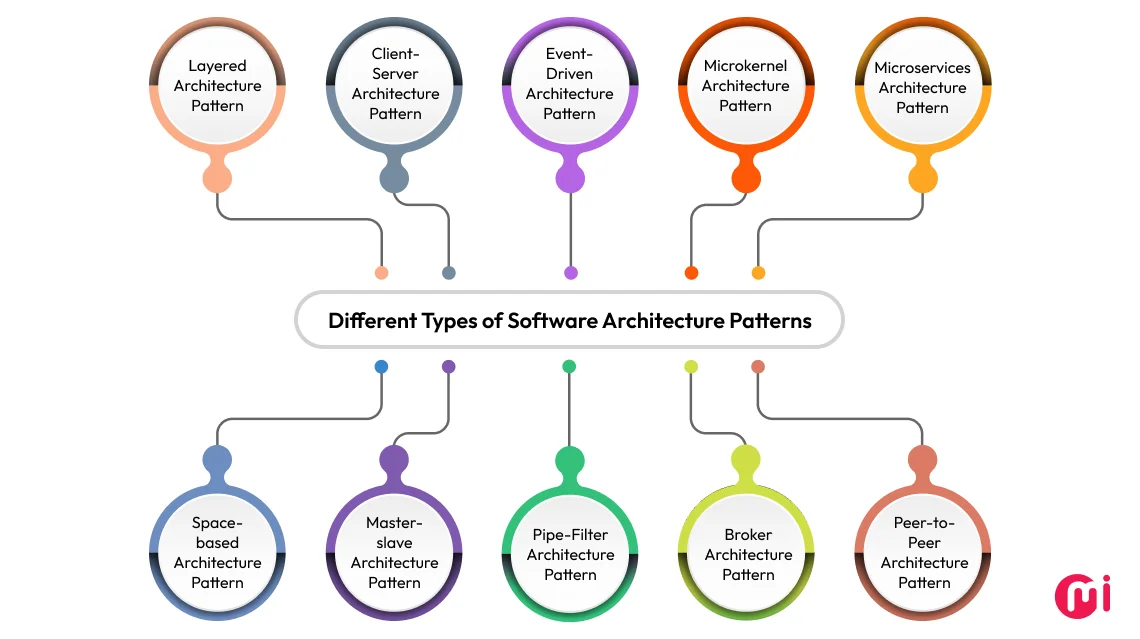

1. Layered Architecture Pattern
Also known as the N-tier architecture pattern, the layered architecture pattern is popular amongst designers and software architects commonly used in software design, specifically for Java EE applications. It organizes software into multiple layers, each responsible for a distinct set of tasks or functionalities.
As one layer is stacked above others, each layer communicates with the layer stacked above or below it, which helps in promoting modularity, maintainability, and separation of concerns.
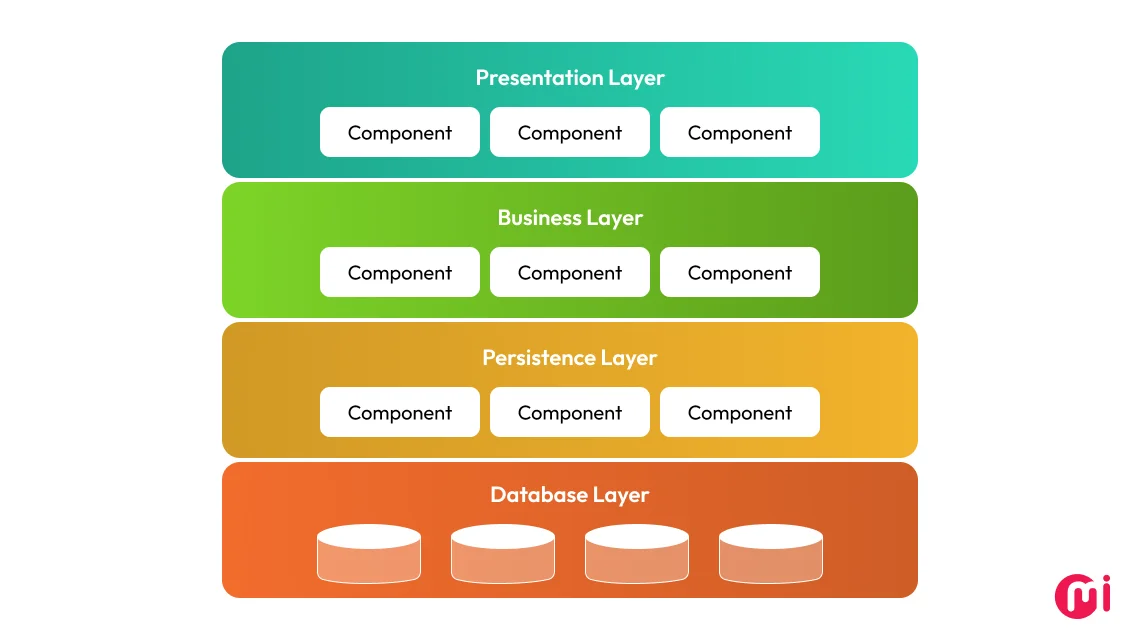

Its different layers include:
- Presentation Layer: This is where we all, as users, interact with the software interface and get information upon prompted requests.
- Business Layer: It handles all business-level operations, validations, and logics and is responsible for executing such upon request.
- Persistent Layer: It acts as a mediator between business and database layers, which manages operations like object-relational mapping.
Data Layer: An independent layer from the application server and business logic interference that manages data operations.
When to Use:
- Building applications with intricate business rules.
- Distinct separation between UI, logic, and data is needed.
- Projects where different teams work on different layers.
- When different layers need to scale independently.
- For systems requiring long-term maintenance or incremental updates.
- To enhance reusability and modularity across the application.
Complexities:
- Can increase latency and reduce overall performance due to abstraction added to each layer.
- May increase the software maintenance and update efforts as changes in one layer ask for changes in other layers as well.
- May not accommodate well for direct or complex interaction between layers without significant restructuring.
- Difficult to scale for high-volume, real-time systems.
- The need for extensive testing and maintaining consistency across layers may increase development and ongoing maintenance costs.
- Often leads to redundant code, increasing maintenance efforts.
Layered Software Architecture Examples:
- Enterprise Relationship Platform (ERP)
- Client Relationship Management (CRM) Platform
- E-commerce Platforms
- Content Management Systems (CMS)
2. Client-Server Architecture Pattern
Connected by two main entities – client and server, this architecture pattern creates a system that hosts, delivers, and manages resources upon requests. The client and server typically communicate over a network, and they may be located on different machines or even in different geographical locations.
This architecture creates a clear division of labor where the client handles the user interface and the server handles data management, business logic, and processing.
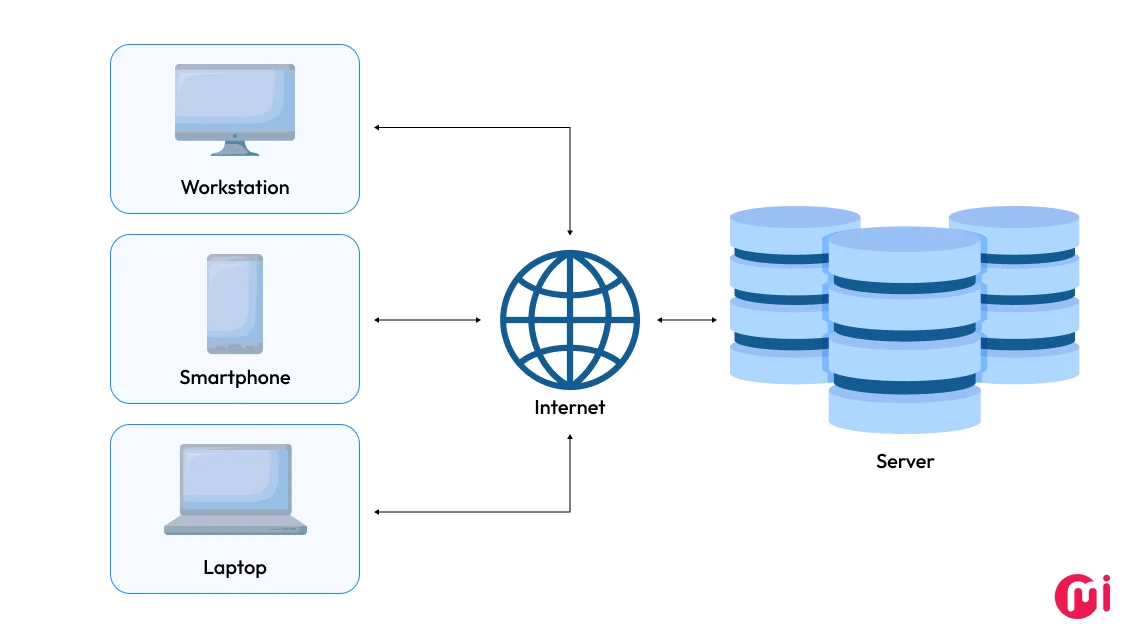

When to Use:
- Developing web applications, like e-commerce platforms, CMS, and social media sites.
- Building systems where multiple clients need access to centralized resources or services, like ERP systems, CRMs, and cloud-based software solutions.
- Developing network-centric applications like chat applications and file-sharing platforms.
- Required to build real-time or on-demand data access-based applications.
Complexities:
- Systems relying on real-time or low-latency responses may face significant issues.
- Might not be a good fit for systems that demand real-time communication with ultra-low latency.
- Server downtime may disrupt all clients.
- At peak load time, the system may slow down or crash in worst-case scenarios.
- If a data breach happens, it can expose all client data, leading to trust issues and regulatory non-compliance.
- A proper synchronization mechanism is needed to avoid inconsistencies in shared data.
Client-Server Software Architecture Examples
- Web Browsing
- Email Systems (like Outlook or Gmail)
3. Event-Driven Architecture Pattern
Agile by core, event-driven architecture is mainly recommended to build systems for your evolving needs and high-performance demands. Software systems built using this architecture pattern are built around the generation, detection, and reaction to events.
In this pattern, components interact by sending and receiving asynchronous events, decoupling them from direct dependencies. Events are typically notifications of changes in state or actions, like a user clicking a button or a sensor capturing data.
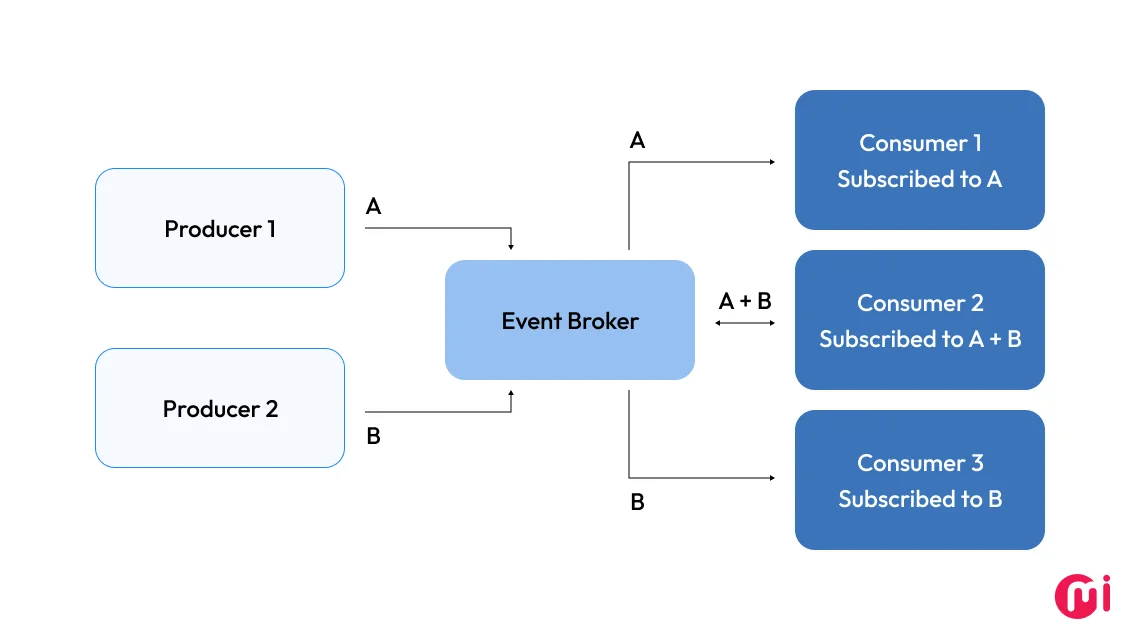

Its key components include:
- Event Producers: Generate events when specific actions or changes occur.
- Event Consumers: Respond to events by performing specific tasks or processing data.
- Event Channels: Enable communication between producers and consumers, often via message brokers or queues (e.g., Kafka, RabbitMQ).
- Event Processors: Intermediate components that process, filter, or route events before they reach consumers.
When to Use:
- Building real-time applications
- Building applications with high scalability needs
- A software system needs to process multiple tasks independently and without blocking operations.
- Systems with continuous data streams from multiple devices that trigger specific actions.
- When workflows require triggering subsequent actions based on events in the system.
- When component failure should not affect the working of the entire system.
Complexities:
- Hard to trace the flow of events across producers and consumers.
- Large volumes of events can overwhelm the system, leading to performance issues.
- Event delivery delays can affect system responsiveness and lead to inconsistent user experiences.
- Ensuring consistent data across components in an asynchronous system can be difficult.
- Managing message brokers, queues, and event logs adds infrastructure complexity.
- Components depend on specific events, creating hidden interdependencies that complicate system changes and updates.
- Using proprietary event brokers or cloud services can make migration to other platforms difficult.
- While scalable, unexpected spikes in event volume can expose limitations in infrastructure or processing capacity.
Event-Driven Software Architecture Examples
- E-commerce platforms
- IoT Systems
- Streaming Platforms
4. Microkernel Architecture Pattern
Also known as plug-in architecture, the microkernel architecture pattern consists of two entities: the core system functionalities (microkernel) and specialized features (plug-in modules).
The core system focuses on essential functionality to maintain operations, while plug-in modules are standalone components designed for specialized tasks.
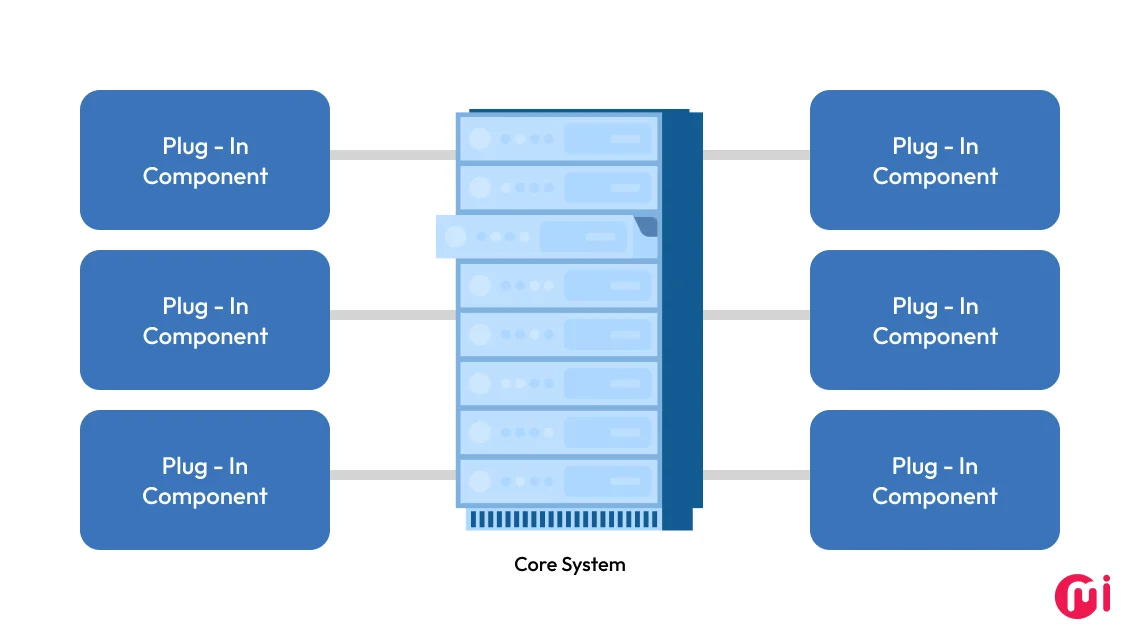

When to Use:
- Systems need modularity and extensibility.
- Building applications with diverse functionalities or evolving requirements.
- Scenarios where feature updates or changes are frequent but shouldn’t disrupt core operations.
- Functionality varies significantly between users or deployments.
- It’s critical to separate the core from additional features to ensure stability.
Complexities:
- There might be integration challenges between the core systems and multiple plug-ins.
- There might be performance overhead issues.
- Plug-ins may have interdependencies, creating complexity in versioning and updates.
- Managing plug-ins can lead to higher memory and processing usage, especially in resource-constrained environments.
Microkernel Software Architecture Examples
- Operating Systems (Linux)
- Plugin-based Software (Adobe Photoshop)
- IoT Systems (Smart Hubs)
5. Microservices Architecture Pattern
You must have heard the popular debate between Microservice Vs. Monolithic architecture pattern. But in the end, microservices architecture won the debate when it comes to developing high-performant and scalable software solutions.
The Microservices Architecture Pattern is a design approach where a large application is built as a suite of small, independently deployable services.
Each service is responsible for a specific business function, such as user management, payment processing, or order fulfillment. These services communicate with each other over lightweight protocols (e.g., HTTP, messaging queues) and are often deployed and scaled independently.
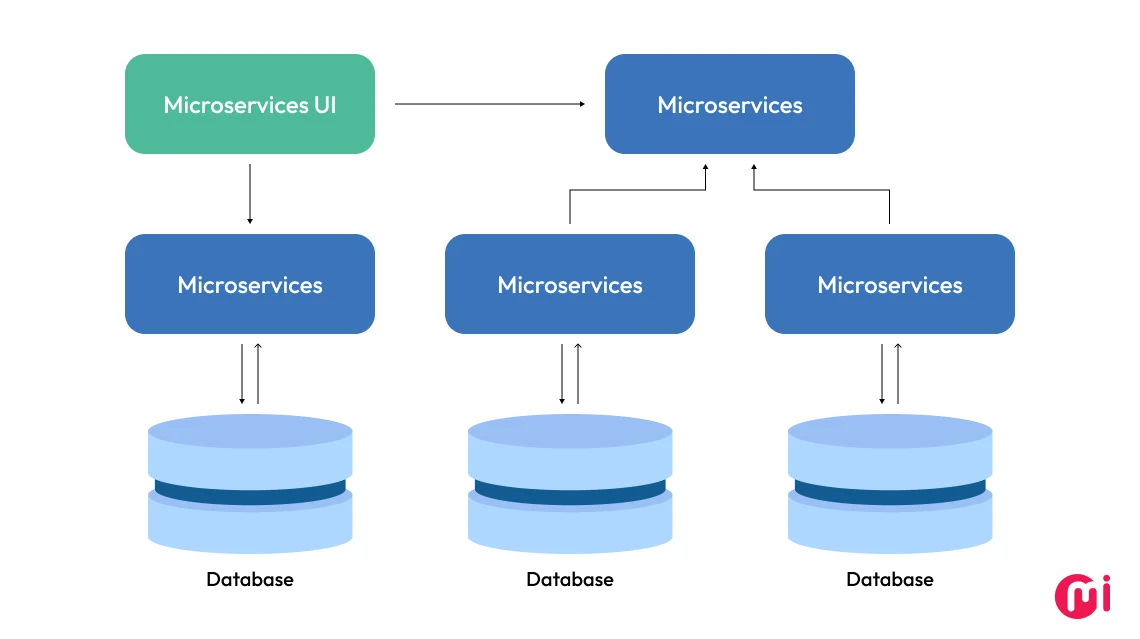

When to Use:
- When an application is too complex to be managed as a monolithic system.
- When there’s a need for agile teams for faster product time-to-market.
- When frequent updates and quick feature releases are needed.
- When different parts of the application need to be scaled independently.
- When uptime is critical, failure in one part should not affect the whole system.
Complexities:
- There might be issues of service communication overhead.
- It can be challenging to manage a distributed system.
- As it uses separate databases, maintaining data consistency can be an effort.
- Load balancing becomes more complex.
- With multiple microservices running independently, maintaining backward compatibility between versions becomes challenging.
- Each service integrated within this architecture needs to be secured independently.
- Refactoring microservices may become complex.
Microservices Software Architecture Examples:
- E-commerce Platforms (Amazon and Etsy)
- Streaming Services (Netflix and Spotify)
- Social Media Apps (Facebook)
Also read: Technologies for Microservices Architecture
6. Space-based Architecture Pattern
Also known as cloud-based architecture or tuple-space architecture, this space-based architecture pattern is a distributed computing pattern designed to handle high traffic and scalability challenges by splitting application workloads across multiple instances.
Here, the term “space” refers to the virtualized data grids that act as shared memory space for all application components, enabling efficient communication and collaboration between services.
These virtualised data grids are also known as in-memory data grids (IMDG) that process and store transient data. So, there will be less reliance on databases, resulting in reduced latency and bottlenecks associated with legacy database-centric designs.
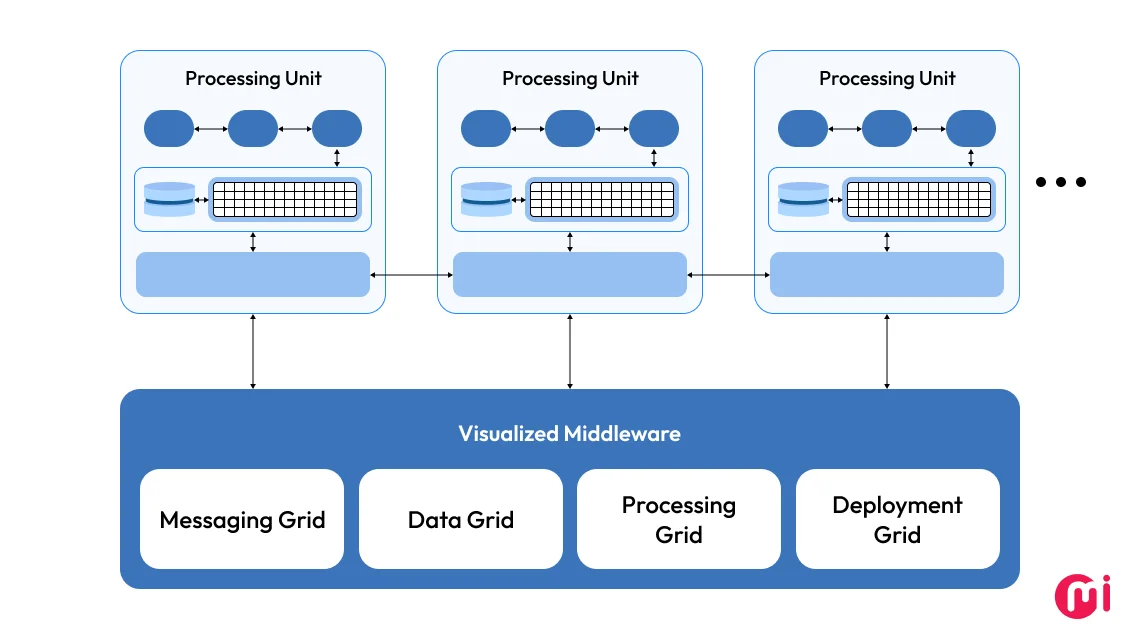

When to Use:
- For building applications that require high scalability, fault tolerance, and performance.
- When real-time processing in software systems is needed.
- Building low-latency applications.
Complexities:
- Data consistency challenges might arise as the system grows.
- Setting up and maintaining infrastructure can be costly.
- Due to its distributed nature, troubleshooting issues can require extra effort.
- There might be latency issues in large-scale deployments.
- Can have vendor lock-in risks.
Space-based Software Architecture Examples:
- E-commerce Platforms
- Financial Services
- IoT systems
- Online Gaming Solutions
7. Master-slave Architecture Pattern
What happens if there are multiple nodes performing different tasks, followed by one master node managing the entire task distribution and compilation of outcomes? There will be better performance for software systems. That’s where the master-slave architecture pattern comes in.
The master-slave architecture pattern is a design approach in which one central component (the master) controls one or more subordinate components (the slaves). The master delegates tasks to the slaves and aggregates their results. This pattern is commonly used in distributed systems to ensure scalability, reliability, and load balancing.
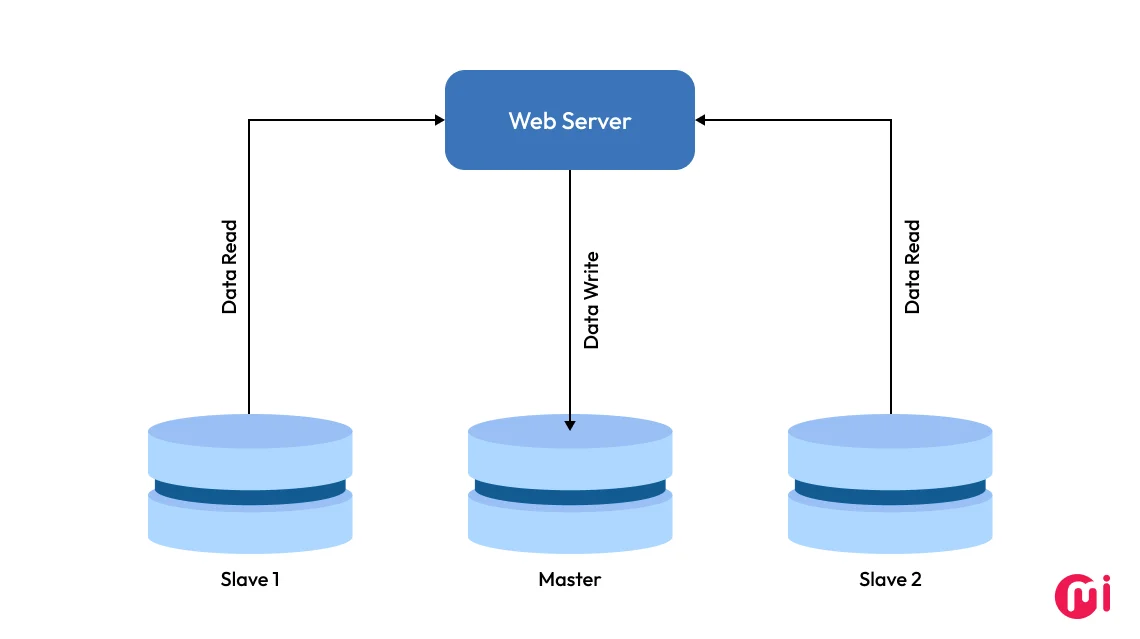

When to Use:
- When tasks need to be processed in parallel to improve efficiency.
- Requirement for data consistency across multiple instances.
- Centralised management is essential
- Read operations need to be offloaded to slaves to reduce the load on the master.
Complexities:
- Needs a robust failover mechanism to avoid a system halt during the failure of the master node.
- Scalability limitations will be there.
- Frequent communication between the master and slaves can lead to latency and reduced performance.
- Detecting and recovering from slave failures without disrupting the workflow adds complexity.
- Tracking issues across a distributed network of slaves will be there.
Master-Slave Software Architecture Examples:
- Database Replication
- Parallel Computing Systems
- Peripheral Devices in Hardware
- Robotics and Automation
8. Pipe-Filter Architecture Pattern
More like event-driven and microservices software architecture patterns, pipe-filter breaks tasks into smaller chunks/sequences of processing steps known as filters, connected by channels called pipes.
Here, each filter performs a specific data operation and passes it to the next in-line filter via a pipe in a streamlined manner. Hence, this type of software architecture pattern is often used for streamlining data processing workflows and creating modular, reusable components.
Because of this, it eases down the software maintenance and offers better scalability and reusability, flexibility in workflow, and better fault isolation.
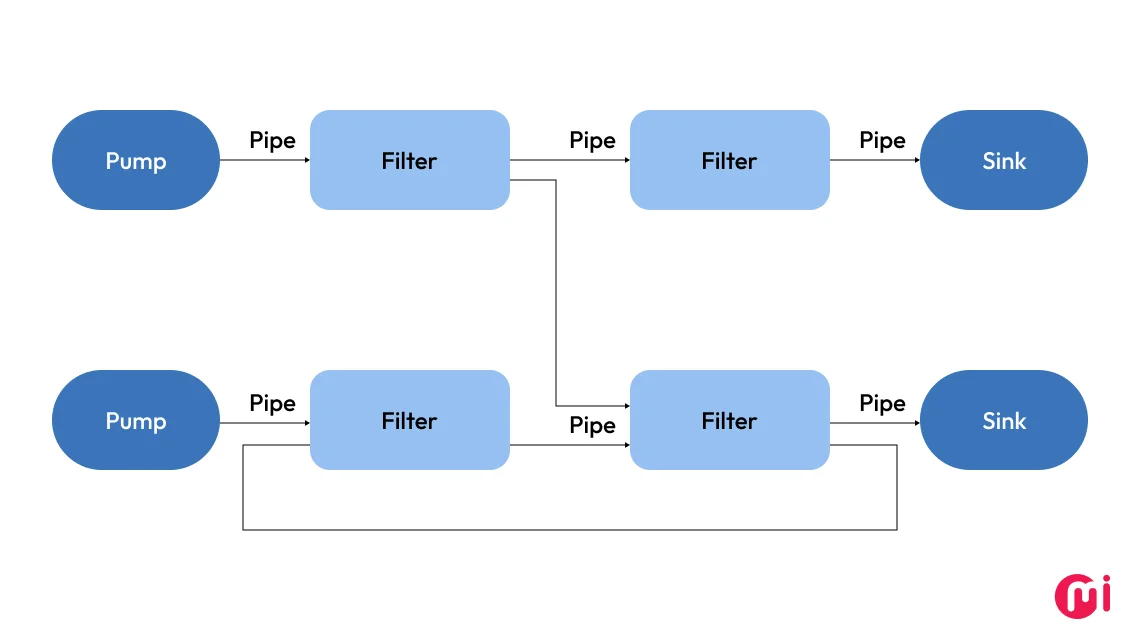

When to Use:
- Building software systems where data needs to pass through a sequence of transformations or operations.
- Ideal for applications requiring continuous processing of data streams.
- Designing modular systems
- Efficient for tasks like log file analysis or report generation, where data is processed in stages.
Complexities:
- Data format dependency.
- Data transfer between filters through pipes in a streaming manner can introduce latency.
- Debugging a particular issue can be challenging.
- Requires high-performant CPU and good memory.
- Adding, removing, or modifying filters in a pipeline may require significant reconfiguration and validation efforts.
Pipe-Filter Software Architecture Examples:
- Compiler Design
- Data Processing Pipelines [ETL (Extract, Transform, Load) systems]
- Media Processing Platforms
- Streaming Applications
9. Broker Architecture Pattern
As for property buying and selling, there’s a broker associated – acting as a middleman for both parties; here, in a software system built with this architecture pattern, a broker acts as a middleman between the software components.
The broker architecture pattern helps to build distributed systems with decoupled components that communicate through brokers. It facilitates communication and data exchange between various client and server components without requiring them to know directly about each other.
This architecture associates components called brokers, clients, servers, proxies, and stubs.
Loose coupling, dynamic discovery, asynchronous communication, and scalability are characteristics that are inherited from the software systems built using it.
When to Use:
- Need for building distributed systems.
- Requirement for dynamic service interactions.
- Requires non-blocking, asynchronous message passing.
- Integration requirement with heterogeneous systems.
- Middleware-based applications.
- Building systems that need to coordinate multiple services/workloads in a distributed environment.
Complexities:
- Failure of the broker can disrupt communication between software components.
- There might be a system performance bottleneck because of the broker.
- Consumes more bandwidth and resources for the processing.
- Can be challenging to streamline messages in a distributed system.
- Complex to maintain and manage message broker infrastructure.
Broker Software Architecture Examples:
- Middleware Systems
- Enterprise Service Buses (ESB)
- Remote Procedure Calls (RPC)
- IoT Systems
10. Peer-to-Peer Architecture Pattern
The peer-to-peer (P2P) architecture patterns consist of peers, where each peer is built of a server and client as a decentralized entity. Instead of being connected to a centralized server, each peer is connected with other peers to share resources, data, and services.
Decentralization, direct communication, scalability, resource sharing, and fault tolerance are the key characteristics of this P2P software architecture pattern.
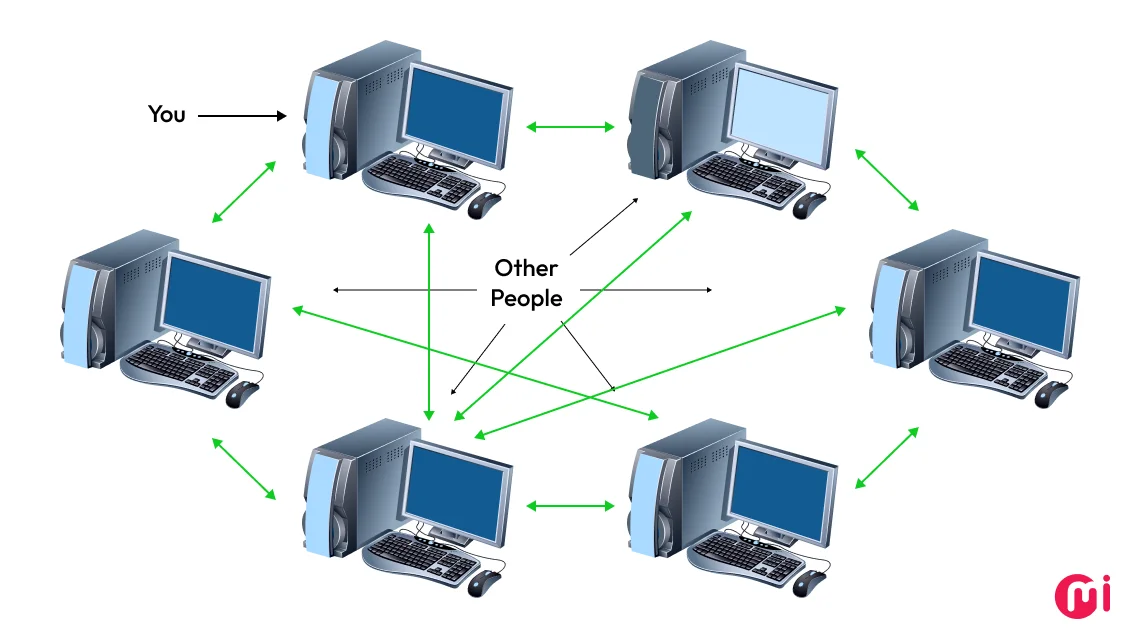

When to Use:
- Building applications that need to avoid central control.
- There are high fault tolerance requirements.
- Building platforms where participants frequently join or leave.
- Requiring distributed collaboration within the system.
Complexity:
- Lack of high-quality services.
- It can be challenging to ensure the robust security of a software system.
- Performance of the architecture may be lacking as more nodes join.
- Complex to manage distributed resources.
- Ensuring system availability and service continuity becomes difficult.
- There are legal and compliance risks associated.
Peer-to-Peer Software Architecture Examples:
- File Sharing
- Blockchain Networks
- Communication Tools like VoIP application
- Distributed Computing
How to Choose the Best Software Architecture Pattern?
Every business wants to develop a software system that performs optimally, scales effectively, and aligns with both present and future needs. To make that possible, it’s crucial to select the right software architecture pattern.
For that, you have to consider several factors impacting the success of your software development project.
Below are the key considerations for choosing the right software architecture pattern:
1. Check for Supportability for Scalability
Scalability in software systems defines how much increasing load it can handle, in terms of users, data, and transactions, without compromising on performance.
To build a software system with better scalability, you need to select an architecture pattern that can match with the expected growth of your application.
A well-chosen architecture ensures that your system will not only handle current traffic but can also grow as your business and technology needs evolve.
2. Analyze the Level of Performance It Can Offer
Your software’s performance is measured by how quickly it responds to user actions. The selection of the right architecture mainly depends on your software concept and the level of performance support it needs.
For example, if you’re developing real-time software systems like messaging systems, financial platforms, or games, they require a software architecture pattern that offers low latency and high throughput. In such a scenario, microservices or event-driven architectures turn out to be the best patterns to adopt.
3. Look into its Assurance for High Availability
Availability of a software system refers to how consistently it operates without downtime. Analysing this factor becomes even more important when developing software solutions like e-commerce platforms, banking systems, or SaaS tools where any downtime can lead to significant business losses or customer dissatisfaction.
If your system needs to be up and running 24/7, high availability is essential. Hence, it becomes essential to look for fault-tolerant and resilient systems that can detect and recover from failures automatically without causing disruptions.
In such a scenario, distributed architectures like microservices or cloud-native come in handy.
4. Evaluate it Security For Software Systems
No matter which software you’re developing. Security of data and its entire ecosystem should always be a priority. This becomes even more important when handling sensitive data, financial transactions, or personal information.
When we say you need to check for how much security your software architecture pattern can provide, we mean it by assessing its ability to prevent unauthorized access, ensure data privacy, and protect against potential threats like data breaches or cyberattacks.
To select the best for your software concept, it’s must to understand the specific security needs and potential threats to your system.
5. Choose the Architecture That Meets Your Budget Constraints
A software development project can typically cost around $10,000 to $200,000. This asks for a big investment. At the same time, the selection of the software architecture pattern plays a vital role in its budget.
Why is that? The complexity of the architecture and the technology stack you choose will influence development, deployment, and ongoing maintenance costs.
When the budget is less and software development requirements are basic, opting for the monolithic architecture is the convenient option.
However, you need to choose the architecture pattern wisely that aligns with your available resources, budget constraints, and expected long-term operational costs.
6. Assess Its Compatibility with Tools & Technology Stack of Your Choice
The tools and technologies available within your development ecosystem play a significant role in determining the right architecture. For instance, certain patterns may be more suited to specific frameworks or tools that your team is already familiar with.
Hence, at the time of selecting software architecture patterns for your system, you should consider whether the tools required for deployment, monitoring, and testing are readily available and support the chosen pattern or not.
Well, the selection of the right one from diverse types of software architecture patterns also depends on which one of the software development trends you’re following.


How Does Mindinventory Help Businesses With Software Architecture Pattern Selection and Designing?
Are you looking to choose the perfect software architecture pattern for your next project? At MindInventory, we’re here to guide you every step of the way. From the discovery phase of the software development to selecting the ideal architecture, designing and developing your solution, rigorous testing, launching, and even post-launch support—we’re your trusted partner throughout the journey.
Why partner with us? MindInventory has earned a reputation as a leading software development company with a proven track record of delivering high-performing solutions. Our projects empower millions of users, enabling seamless operations and measurable success.
Here’s a glimpse of our impact:
- Zooop: A SaaS-based transportation management system that tracks 5,000+ fleets in real time, boasts a 92% on-time delivery rate, and has delivered a remarkable 150% ROI.
- SidePocket: A tactical asset allocation robo-advising app catering to 2,500+ monthly active users, managing over 1M transactions monthly, and achieving an impressive 8.5% average annual ROI on portfolios.
And these are just two examples. We’ve consistently delivered exceptional results, helping businesses operate smoothly and stay ahead in a rapidly evolving tech landscape.
Ready to gain a competitive edge with the best software architecture pattern for your project? Let’s work together to make it happen! Reach out to us today and take the first step toward success.
FAQs About Software Architecture Patterns
Software architecture patterns define the high-level structure of systems, while design patterns focus on the specific implementation. Architecture patterns handle large-scale components, whereas design patterns address finer details like entity behavior and relationships.
A monolithic architecture is a single, unified application where all components are tightly integrated and run as one. It’s simpler to develop initially but can become difficult to scale and maintain as the system grows.
In contrast, a microservices architecture breaks down the application into smaller, independent services, each responsible for a specific function. This approach allows for greater scalability, flexibility, and easier updates, but it’s more complex to set up and manage.
Yes, switching architecture patterns during software development is indeed possible. However, it comes with certain considerations and implications. So, to make that possible, you need to consider the feasibility of switching patterns:
For example, in the early stage, it’s more feasible to switch architecture patterns when fewer dependencies have been established.
In the mid- to Elate-development stage, changing the underlying architecture patterns can lead to significant refactoring as the codebase can become more complex.
#1 When there are new developments in insights suggesting to switch.
#2 When the current performance metrics indicate that the current architecture isn’t meeting expectations.
#3 When maintainability can be an issue.
Yes, significantly. Different patterns offer varying degrees of scalability based on how they manage resources, data, and component interactions.


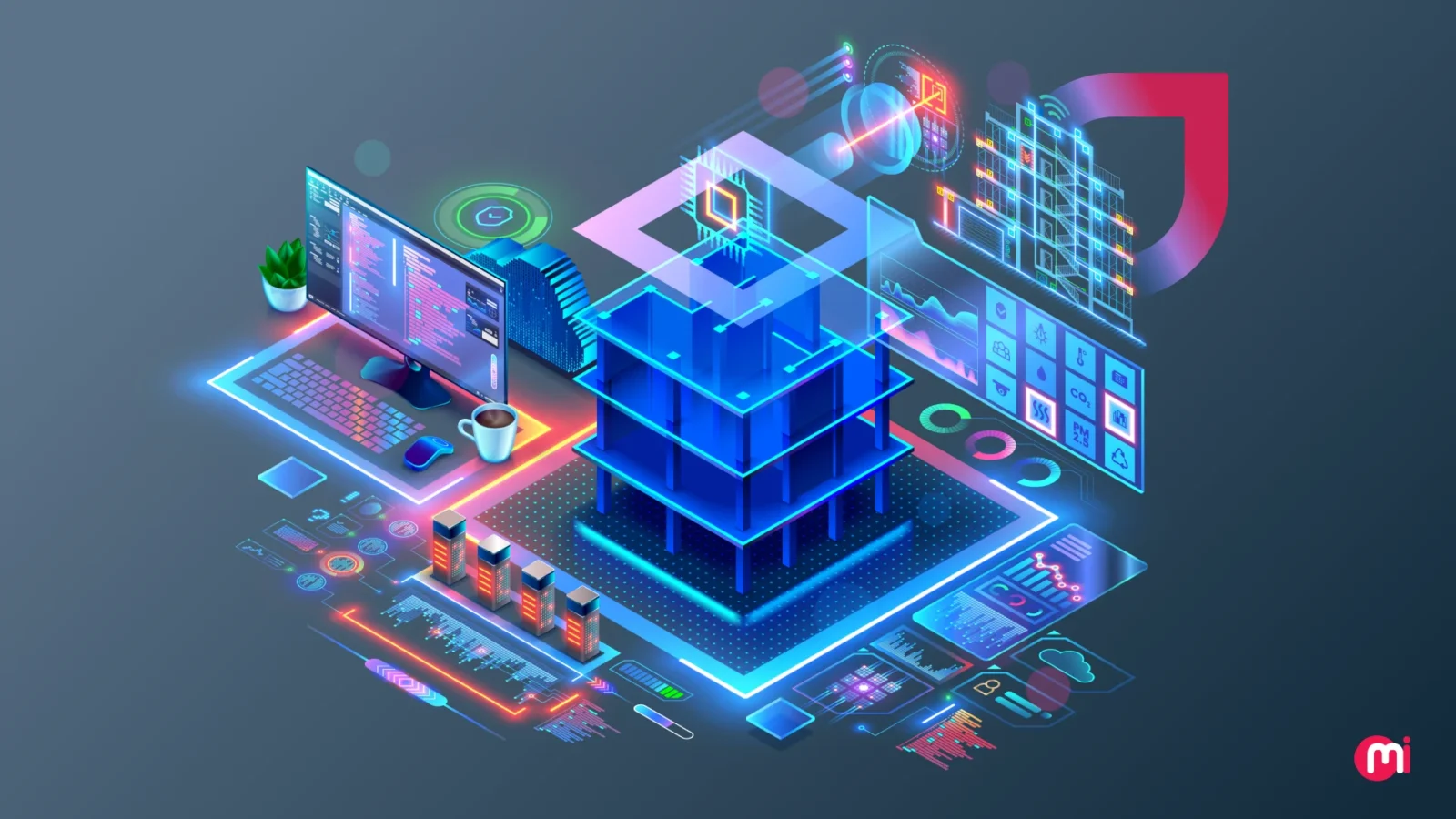










Leave a Reply